.
Mt. Ougiyama 扇山 – Mt. Momokurayama 百蔵山
Distance: 13.4 km
Elevation change: 824 metres
Highest point: 1138 metres
Start: Torisawa Station (Chuo Main Line)
Finish: Saruhashi Station (Chuo Main Line)
Difficulty: ▅▅▅▅▅▅▅▅▅▅ ❸
Map: Yama to Kogen Chizu 山と高原地図 [No.29 高尾・陣馬 TAKAO·JINBA]
GPX TrackKML TrackGSI MAPPDF Topo Map
Two Prodigious Views of Mt. Fuji
Clear winter skies provide exquisite views of the Japanese Alps, which are often masked in a slight haze throughout the warmer months. This circumstance was taken advantage of on this latest outing, which truly conveyed the majesty of Mt. Fuji. Although a somewhat underrated hike, its location just inside Yamanashi Prefecture provides splendid views of Mt. Fuji from two prominent peaks.
The hike begins at Torisawa Station, 鳥沢駅 around 90 minutes from Shinjuku. From the station, head across the street, which leads under the Chuo Expressway. The road then loops around to the left and back up the hill near the Otsuki Country Golf Club. Along the road shadowing the golf course, look for a sign on your left 梨の木平 Nashi no kihira allowing you to bypass a section of road. A further 10 minutes after exiting back onto the road, you should arrive at the trailhead on your left side. The route from the station is generally well marked with several signs pointing you in the direction of Mt. Ougiyama and takes approximately one hour to reach this point.
At the trailhead, there are toilet amenities, some benches to sit on, and a map of the area. The trail to the summit of Mt. Ougiyama 扇山 (1,138 m) is interlaced with switchbacks to ease the climb, though it becomes steeper over the last section. After about 30 minutes, there is a water hole to fill up. At the ridgeline 大久保のコル Ookubo no koru turn right towards Mt. Ougiyama. From here, it is about 10 minutes to the summit. Arriving at the summit of Mt. Ougiyama, there was a fair amount of snow and pretty much no hikers, though more importantly, stunning views of Mt. Fuji were to be had.
After taking a short breather, head back down the ridge to Ookubo no koru where the trail maintains a gradual descent. This section of trail receives a fair dusting of snow cover through the winter, so it is advisable to carry some ski poles to steady your footing. After around an hour, you will see a metal pole with a red arrow (unlabeled) where you turn left for the final and, at times, rather steep ascent to Mt. Momokurayama 百蔵山 (1,003 m). While the peak of Mt. Momokurayama has tree cover, excellent views are afforded towards Mt. Fuji and Otsuki City, which makes for a well-deserved lunch spot.
When you’re ready to head off, continue in a westerly direction across the summit for 10 minutes, where you should find a marker on your left that heads towards Saruhashi Station 猿橋駅. More views of Otsuki City are provided, and a water hole is situated around halfway down. When you arrive at the parking area and small shrine, take care not to follow the winding road; instead, look for a narrow road that begins at the bottom of the stairs. From the car park, it takes around 40 minutes to reach the station. When the narrow road converges, turn right onto a main road, which passes an athletics field. Further down, cross over a bridge and head back under the Chuo Expressway. The station is located right next to the 7-Eleven on the opposite side of the pedestrian bridge. Again, look for well-marked signage pointing you in the direction of the station.
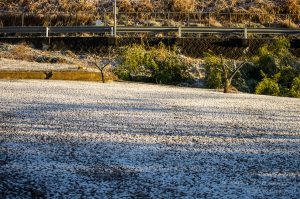
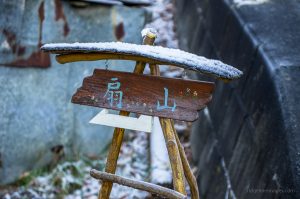

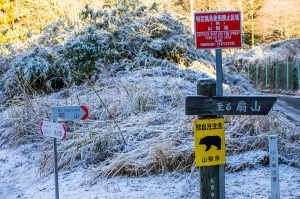



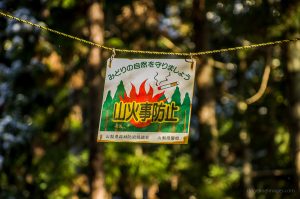
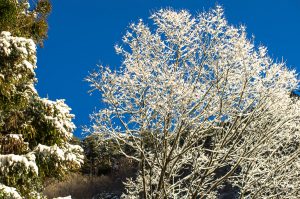

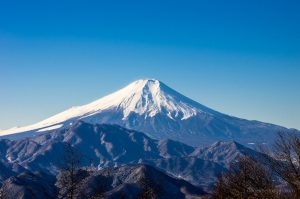
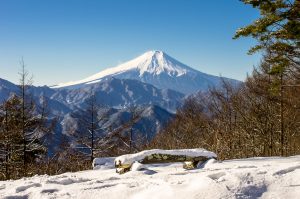
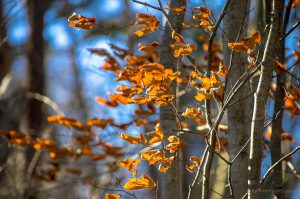
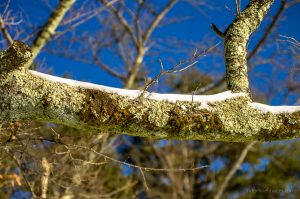
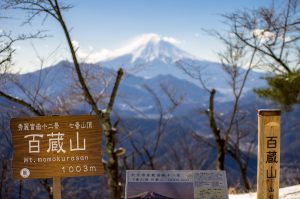
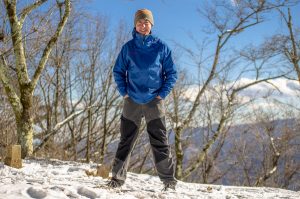
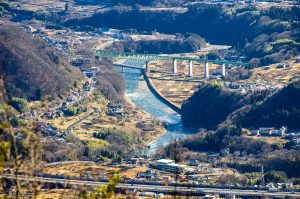
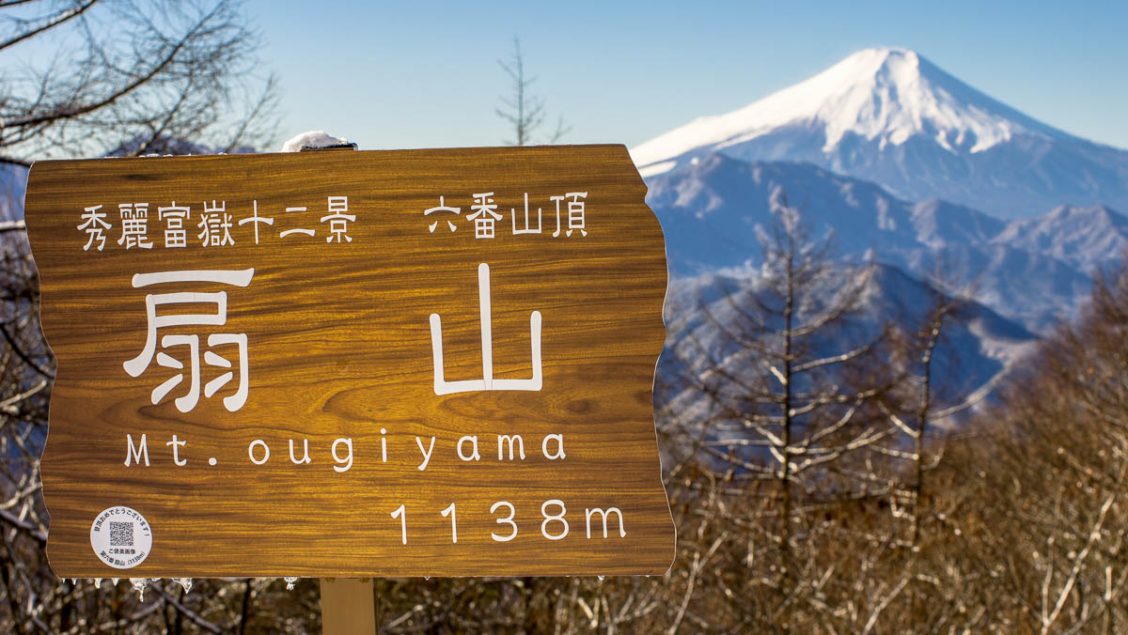





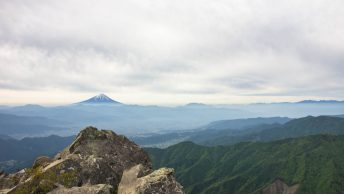
Dear David,
This is Lyn again, the one hoping to hike around the Tokyo area in December with my family of 5. We’ve made arrangements for the Tanzawa Traverse, but are still trying to decide on the 2nd hike. As we will be staying near the Minami gyotoku station, the three hour travelling time to get to the start of the Mitsuge- toge -yama hike is rather daunting, so I am considering the Mt Ougiyama hike instead. Would it normally be do-able in early December?
In your experience, would light crampons be necessary when doing the Tanzawa Traverse early December (2-3 December)? By the way, I found your hiking trails, with all the waypoints embedded, really helpful. Thanks for sharing all your input!
Thank you.
Cheers,
Lyn
Hi Lyn,
I know Minami Gyotoku as I used to live nearby in Kasai and is nicely located if you’re planning a day outing with the family to Tokyo Disneyland. As for Mt. Ougiyama in early December there is likely to be little or no snow so it’s certainly do-able. The same goes for Mt. Tanzawa at that time of year the summit is usually snow free though it will be cold. I just had a look at last year’s temperatures at Miyama-sansou and for early December night time averages are around -5℃ and daytime about 5℃ so please pack accordingly. Regular hiking footwear is fine for both hikes so no need for crampons.
Hi David,
Thanks for the advice about the cold up there. We will certainly pack coldwear along. It’s good to know crampons won’t be necessary. We actually chose the apartment near Minami Gyotoku for its spaciousness rather than its nearness to Tokyo Disneyland. Would there be any other hikes nearer to Minami Gyotoku that you would recommend? I tried to find accommodation nearer to Shinjuku but most were too small or very expensive.
Your input has really been much appreciated.
Regards,
Lyn
Chiba’s most famous hiking spot is Mt. Nokogiri but unfortunately quite far from where your staying. Equally there is a great campsite at Uchiurayama Kenmin no Mori near Katsuura with around 50 campsites and plenty of lodges to stay. Failing that I would definitely recommend grabbing some bikes or walking down to the Kasai Rinkai Koen which is a lovely place to spend the afternoon.
Hi David,
Thanks for your suggestions. Uchiurayama Kenmin no Mori looks very interesting!
Regards,
Lyn
Hi David,
I was searching for good hiking trails near Tokyo for late December (around Christmas) and I stumbled on your link “The best day hikes around Tokyo”. And out of all those Mt Ougiyama looks amazing. So I was wondering if the trail is open in late December? And any special gear is needed hike it.
Thank you for your feedback and suggestions
Cheers
Ravi (Singapore)
Hi Ravi, yes the Mt. Ougiyama trail is open year round. I just checked my notes and I hiked it on December 28th last year and while crampons aren’t necessary there will most likely be a fair amount of snow, just to be safe I would recommend taking along some trekking poles.
Thank you very much David. Really appreciate your guidance.
Cheers!!
Ravi
Hi David, I hiked up Mt. Ougiyama on Jan. 27th, 2015. While the climb up was snow-free, crampons were definitely needed on the descent down the north-facing slope. Ditto for the mountain on the opposite side of the valley, Mt. Kuradake, which I climbed one week earlier. Having poles also left me feeling that I was more fully in control.
Wise decision Patrick bringing along the trekking poles as they definitely provide extra stability and confidence when needed.
Hi David,
I just want to say thank you for all the information on your site. Without all the pictures and the description I would have been not brave enough to go hiking around Tokyo, because I cannot speak any Japanese. But so I had one wonderful day with the tour for Mt. Ougiyama 扇山 – Mt. Momokurasan 百蔵山 yesterday. And two weeks ago another tour to Mt. Hinodeyama 日の出山 – Mt. Mitake 御岳山. The weather was perfect, some people but not to crowded.
Cheers
Julius (from Germany)
Hey Julius, I’m so pleased that you had a great hike. This is one of my favourite times of year for hiking with crisp cold mornings and few people out and about on the trails. I really appreciate the feedback also. Thank you and all the best.
[…] To get around we followed the instructions from this blog which were spot on: https://ridgelineimages.com/hiking/mt-ougiyama/ […]
Hi all,
How do you check the weather forecast of these 2 peaks. I am unable to find forecast for the mountains in google or mountainweather sites. Is it enough if I just check the yamanashi-shi weather ??
Checking the local Yamanashi weather is OK, though your better bet would be to check the mountain forecast for Mt. Ougiyama at tenki to kurasu http://goo.gl/9qpzYb
thanks a lot
going this weekend.
Thanks for the recommended hike and details. Just went today and was not disappointed – views were great! I saw another hiker about every 10 minutes and there were 5-6 groups at the summit of Mt. Ougiyama. There were about half as many people on Mt. Momokurasan. Your descriptions and map were helpful, especially when the map was viewed with “terrain” turned on to show topo lines. There was a slight discrepancy for the left turn marker 10 mins down from the peak of Mt. Momokurasan – the marker was on the right (not left), marking the trail which T’s in from the left, and it was a couple hundred meters past where your GPS path seemed to turn left. It made me wonder for a few minutes, so I thought I’d point it out for the next person… Thanks again – great hike!
Glad you enjoyed the hike and you certainly picked an awesome day for it. Thanks for clarifying the discrepancy in the trail notes also.
Nice blog mate! Especially digging the haikyo stuff, and Mt Ougiyama looks great, I’ll put it at the top of the list for my next visit to Tokyo… I hiked Kuratake last time, which was nice but no Fuji view that day.
Anyway, I don’t think I can fit in a 6 hour hike out there (including the travel time) when I come back, but 3 hours I can do so just wanted to ask what you’d estimate the hiking time to be to go straight up & down Ougiyama without including Momokurasan? 3 hours enough?
Hi Simon, thanks for the compliments. As for Mt. Ougiyama while it isn’t a particularly strenuous hike I would allow for around 3-3.5 hours to get up and down comfortably.
Nice one, thanks for the info! Think I’ll pencil this hike in for my next visit, cheers
Hi David
Firstly, many thanks for putting your time and effort into this website. It will literally make our time in Tokyo/Japan a more enjoyable experience.
After moving here in June, last week we did this hike as our first hike in Japan, and what a great first hike it was. Perfect late autumn/early winter weather. We only saw 2 other groups the whole day. And your rating of moderate was about right. The only dampener was that Mt Fuji was clouded over, which I understand is not unusual.
A couple of questions/clarifications:
a) I think the numbering of some of the Mapple Mountains & Highlands topographical maps you reference has changed, i.e. the Takao & Jinba map now appears to be 28 rather than 27.
b) Do we really need to concern ourselves with the bears? And if yes, what’s the practical approach (I certainly don’t want to pierce the peace & quiet by carrying a bell around everywhere).
All the best,
Rob.
Hi Rob,
Thanks for your comment and clarifications. I hadn’t realized but it appears that the Yama-to-Kogen map numbers have indeed been revised, so I appreciate the heads up. Regarding bears, the probability of coming across one in the Kanto area is fairly slim so I wouldn’t worry about it. In lieu of a ‘bear bell’ a better approach to is to make a little noise when you’re out and about so as to not surprise them.
Hi David
Yeh, it looks like it may be just one of the maps that has changed number.
Suspected as much with the bears.
One more question: What 1 or 2 day hikes near Tokyo (no more than 3 hour drive) would you recommend over Jan/Feb/Mar, if any. Happy to use crampons + walking axe in some sections if required.
Look forward to providing some more feedback on future hikes!!
All the best,
Rob.
Rob, the winter often provides some of the best views which makes it an excellent time to hit the trails. Note however many peaks including those surrounding Tokyo above 1,000 meters are snow covered so carrying some 4-point crampons along with trekking poles is a good idea. For days hikes I recommend Mt. Oyama, Mt. Daibosatsu and Mt. Gangaharasuri and for a little further afield consider Mt. Tanzawa and Mt. Kentoku though some exposure and use of chains is required on this last one. Hope this helps 🙂
Hi, David.
Did this one today, superb hike, amazing scenery. Fuji san was great from both angles. Found a dead boar, poor guy, most likely roadkill. Sending you two Kofis for the two mountains. Thanks always for the great advice and clear instructions!
Hey Francisco, you picked a great day for the hike and it’s always nice to have killer views of Fuji san. By chance I past those mountains this weekend on my way to Mt. Kasatori where I also had an awesome panorama of the big fella. Cheers for the Kofis 🙂
Hi David, I’ve followed your 3 of your hikes now and really appreciate the overviews and the routes on ride with GPS. What a great site! I did this one and, for me, the data on my apple watch was different. Closer to 1138 on the elevation gain. Is elevation gain, elevation change? All the uphill that will be covered when including initial ascent and all the ascents that follow? Thanks for sharing your hikes and advice.
Hi Jackie, glad to hear you’ve tried several hikes and thanks for your kind words about the blog. Just to briefly explain the elevation change I include is the difference between the lowest and highest points along the hike. For the Ougiyama hike it’s 824 m. By contrast the cumulative elevation gain is the total amount you will climb, and cumulative elevation loss the total amount you will descend. This information is recorded above the ‘Ride with GPS’ map +1,046 m / -1,040 m. This second figure is probably what your Apple watch recorded. There will usually be some discrepancy depending on the GPS device used and precise route taken.
I did this one today (Jan 18, 2025). I took a shorter loop and didn’t go to Mt. Momokurasan and instead returned to Torizawa Station. The views of Mt Fuji during the ascent and at the summit were great. The descent on this route was an easy trail through the forest with the last ~30 minutes on the road.
Thanks as always for the great site and guides.
Glad to hear you got some good views of Fujisan! I’m planning to climb Momokurasan as a standalone peak after the next decent snowfall.
Sounds good. I debated doing both, but finely took it easy.
I am not sure I am ready for a snow hike yet, so I’ve enjoyed getting some hikes done before the snow.